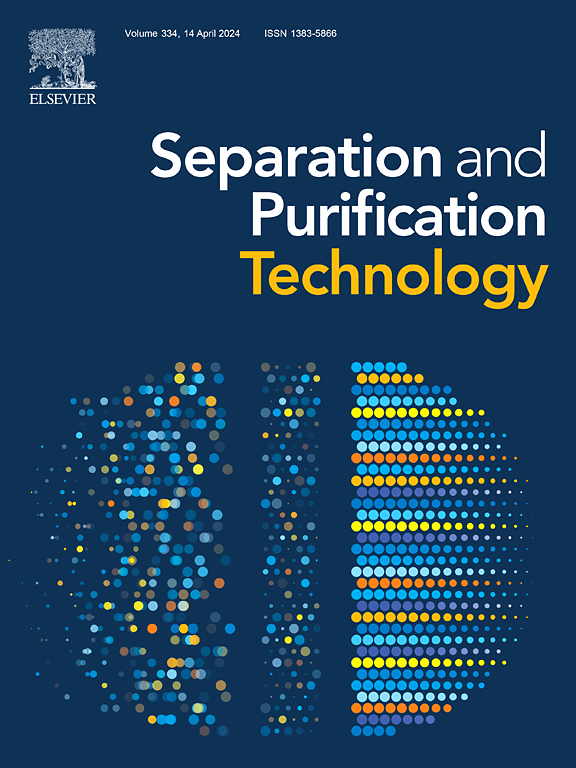Bimetallic modified sludge biochar for enhanced peroxodisulfate activation and radical induction
IF 8.1
1区 工程技术
Q1 ENGINEERING, CHEMICAL
引用次数: 0
Abstract
The development of water treatment technologies had been advanced through the induction of directional radical generation. However, despite their promising potential, the uncertain selectivity and structural complexity of these systems have continued to affect the efficiency of pollutant degradation. In this study, peroxodisulfate (PDS) activation and degradation were achieved by combining different bimetallic systems (FeAl, FeNi and FeCu). The results demonstrated that the FeAl-SBC, FeNi-SBC and FeCu-SBC systems achieved degradation rates of over 90 % for tetracycline (TC). And it was confirmed by EPR results that the main contributing radicals in the degradation systems of FeAl-SBC, FeNi-SBC and FeCu-SBC were 1O2, O2•−, •OH and SO4•−. Density Functional Theory (DFT) studies revealed that the constructed Fe-O-Al, Fe-O-Ni and Fe-O-Cu structures exhibited energy gaps of 1.069 eV, 0.423 eV and 0.138 eV, respectively. These energy gaps induced distinct electron-rich environments, which played a critical role in generating different radicals. Under the synergistic effects of the bimetallic systems, the Fe3+/Fe2+ redox cycle was found to promote radical formation. Notably, these systems exhibited a broad scope of application, demonstrating wide adaptability to various organic pollutants and water environments. Based on LC-MS and Fukui function calculations, the degradation pathways of TC were proposed. Overall, these insights significantly enhanced the understanding of bimetallic systems in advanced oxidation processes.
双金属改性污泥生物炭增强过氧二硫酸活化和自由基诱导
通过诱导定向自由基的产生,促进了水处理技术的发展。然而,尽管它们有很大的潜力,但这些系统的不确定选择性和结构复杂性继续影响污染物降解的效率。在本研究中,通过结合不同的双金属体系(FeAl, FeNi和FeCu)来实现过硫酸盐(PDS)的活化和降解。结果表明,FeAl-SBC、FeNi-SBC和FeCu-SBC体系对四环素(TC)的降解率均在90 %以上。EPR结果证实FeAl-SBC、FeNi-SBC和FeCu-SBC降解体系中主要贡献自由基为1O2、O2•−、•OH和SO4•−。密度泛函理论(DFT)研究表明,Fe-O-Al、Fe-O-Ni和Fe-O-Cu结构的能隙分别为1.069 eV、0.423 eV和0.138 eV。这些能隙诱导了不同的富电子环境,这在产生不同的自由基中起着关键作用。在双金属体系的协同作用下,发现Fe3+/Fe2+氧化还原循环促进自由基的形成。值得注意的是,这些系统具有广泛的应用范围,对各种有机污染物和水环境具有广泛的适应性。基于LC-MS和Fukui函数计算,提出了TC的降解途径。总的来说,这些见解显著增强了对高级氧化过程中双金属系统的理解。
本文章由计算机程序翻译,如有差异,请以英文原文为准。
求助全文
约1分钟内获得全文
求助全文
来源期刊

Separation and Purification Technology
工程技术-工程:化工
CiteScore
14.00
自引率
12.80%
发文量
2347
审稿时长
43 days
期刊介绍:
Separation and Purification Technology is a premier journal committed to sharing innovative methods for separation and purification in chemical and environmental engineering, encompassing both homogeneous solutions and heterogeneous mixtures. Our scope includes the separation and/or purification of liquids, vapors, and gases, as well as carbon capture and separation techniques. However, it's important to note that methods solely intended for analytical purposes are not within the scope of the journal. Additionally, disciplines such as soil science, polymer science, and metallurgy fall outside the purview of Separation and Purification Technology. Join us in advancing the field of separation and purification methods for sustainable solutions in chemical and environmental engineering.
 求助内容:
求助内容: 应助结果提醒方式:
应助结果提醒方式:


